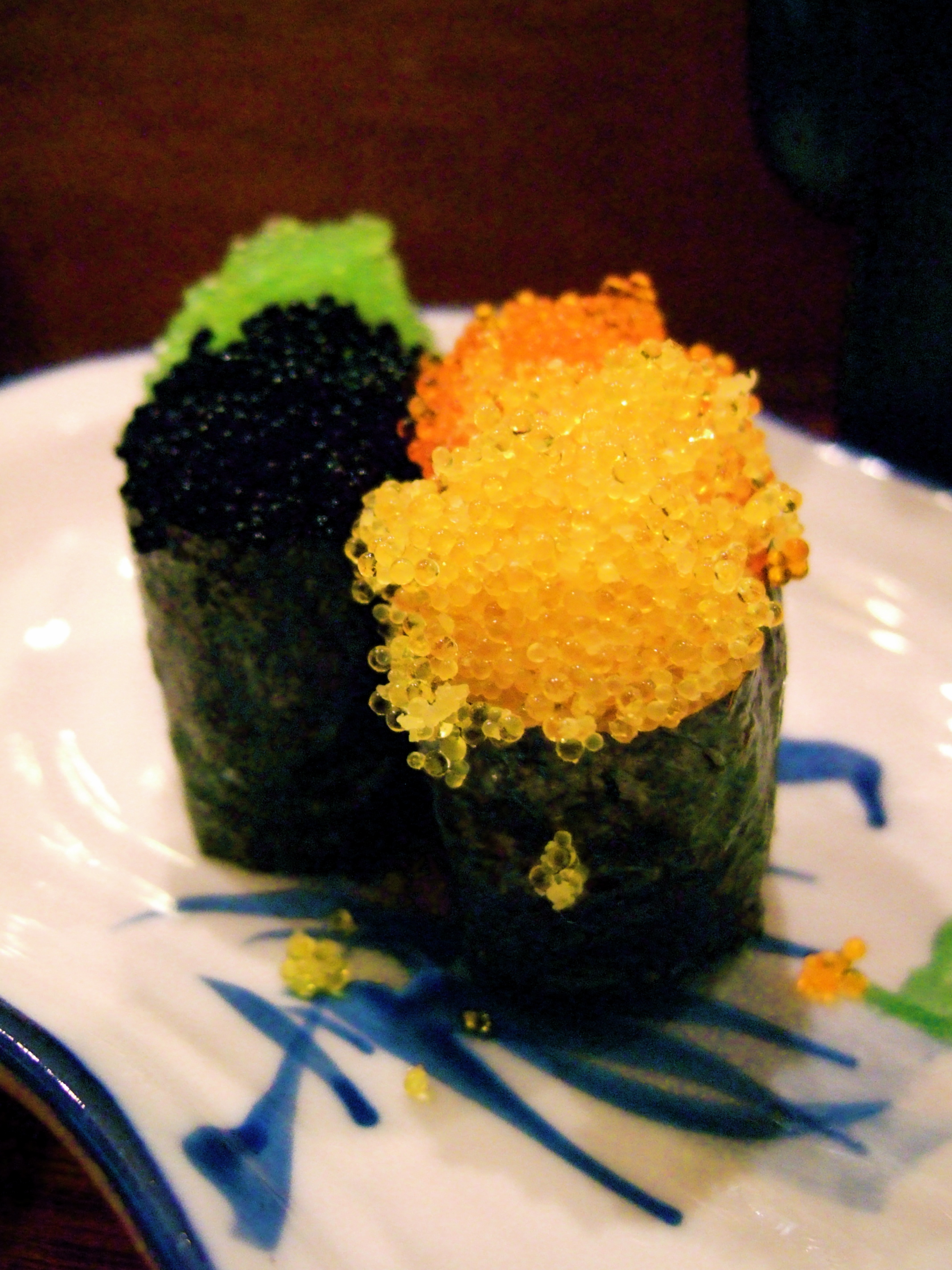Tobiko on:
[Wikipedia]
[Google]
[Amazon]
is 
Self Nutrition Data
/ref>
California Sushi mit Kaviar (26545022496).jpg, California roll covered in ''tobiko''
File:Sushi mit Caviar (25966193204).jpg
Tobiko on grilled Albacore.jpg, ''Tobiko'', shown in its natural color, topping grilled albacore tuna
flying fish
The Exocoetidae are a family (biology), family of Saltwater fish, marine Actinopterygii, ray-finned fish in the order (biology), order Beloniformes, known colloquially as flying fish or flying cod. About 64 species are grouped in seven genus, ge ...
roe
Roe, ( ) or hard roe, is the fully ripe internal egg masses in the ovaries, or the released external egg masses, of fish and certain marine animals such as shrimp, scallop, sea urchins and squid. As a seafood, roe is used both as a cooking, c ...
in Japanese cuisine
Japanese cuisine encompasses the regional and traditional foods of Japan, which have developed through centuries of political, economic, and social changes. The traditional cuisine of Japan (Japanese language, Japanese: ) is based on rice with m ...
, known for its use in ''sushi
is a traditional Japanese dish made with , typically seasoned with sugar and salt, and combined with a variety of , such as seafood, vegetables, or meat: raw seafood is the most common, although some may be cooked. While sushi comes in n ...
''.

Description
The eggs are small, ranging from 0.5 to 0.8 mm. For comparison, ''tobiko'' is larger than '' masago'' ( capelin roe), but smaller than '' ikura'' (salmon
Salmon (; : salmon) are any of several list of commercially important fish species, commercially important species of euryhaline ray-finned fish from the genera ''Salmo'' and ''Oncorhynchus'' of the family (biology), family Salmonidae, native ...
roe). Natural ''tobiko'' has a red-orange color, a mild smoky or salty taste, and a crunchy texture.
''Tobiko'' is sometimes colored to change its appearance: other natural ingredients are used to accomplish the change, such as squid ink to make it black, ''yuzu
Yuzu (''Citrus'' × ''junos'', from Japanese language, Japanese or ; ) is a citrus fruit and plant in the family Rutaceae of China, Chinese origin. Yuzu has been cultivated mainly in East Asia, though it has also recently been grown in New Z ...
'' to make it pale orange (almost yellow), or even ''wasabi
Wasabi (Japanese language, Japanese: , , or , ) or Japanese horseradish (''Eutrema japonicum'' syn. ''Wasabia japonica'') is a plant of the family Brassicaceae, which also includes horseradish and Mustard plant, mustard in other genus, genera. ...
'' to make it green and spicy. A serving of ''tobiko'' can contain several pieces, each having a different color.
When prepared as ''sashimi
is a Japanese cuisine, Japanese delicacy consisting of fresh raw fish or Raw meat, meat sliced into thin pieces and often eaten with soy sauce.
Origin
The word ''sashimi'' means 'pierced body', i.e., "wikt:刺身, 刺身" = ''sashimi'', whe ...
'', it may be presented on avocado
The avocado, alligator pear or avocado pear (''Persea americana'') is an evergreen tree in the laurel family (Lauraceae). It is native to Americas, the Americas and was first domesticated in Mesoamerica more than 5,000 years ago. It was priz ...
halves or wedges. ''Tobiko'' is used in the creation of many other Japanese dishes. Often, it is used as an ingredient in California rolls.
Frequently, ''masago'' (capelin or smelt roe) is substituted for ''tobiko'', due to its similar appearance and flavor. Tobiko is also sometimes "adulterated" with dyed herring eggs.
Nutrition
The raw roe is very nutritious, due to its highvitamin
Vitamins are Organic compound, organic molecules (or a set of closely related molecules called vitamer, vitamers) that are essential to an organism in small quantities for proper metabolism, metabolic function. Nutrient#Essential nutrients, ...
content, high protein
Proteins are large biomolecules and macromolecules that comprise one or more long chains of amino acid residue (biochemistry), residues. Proteins perform a vast array of functions within organisms, including Enzyme catalysis, catalysing metab ...
content, and large ratio of omega-3 to omega-6
Omega−6 fatty acids (also referred to as ω−6 fatty acids or ''n''−6 fatty acids) are a family of polyunsaturated fatty acids (PUFA) that share a final carbon-carbon double bond in the ''n''−6 position, that is, the sixth bond, count ...
fatty acids./ref>
Gallery
References
External links
* {{Roe Japanese seafood Roe